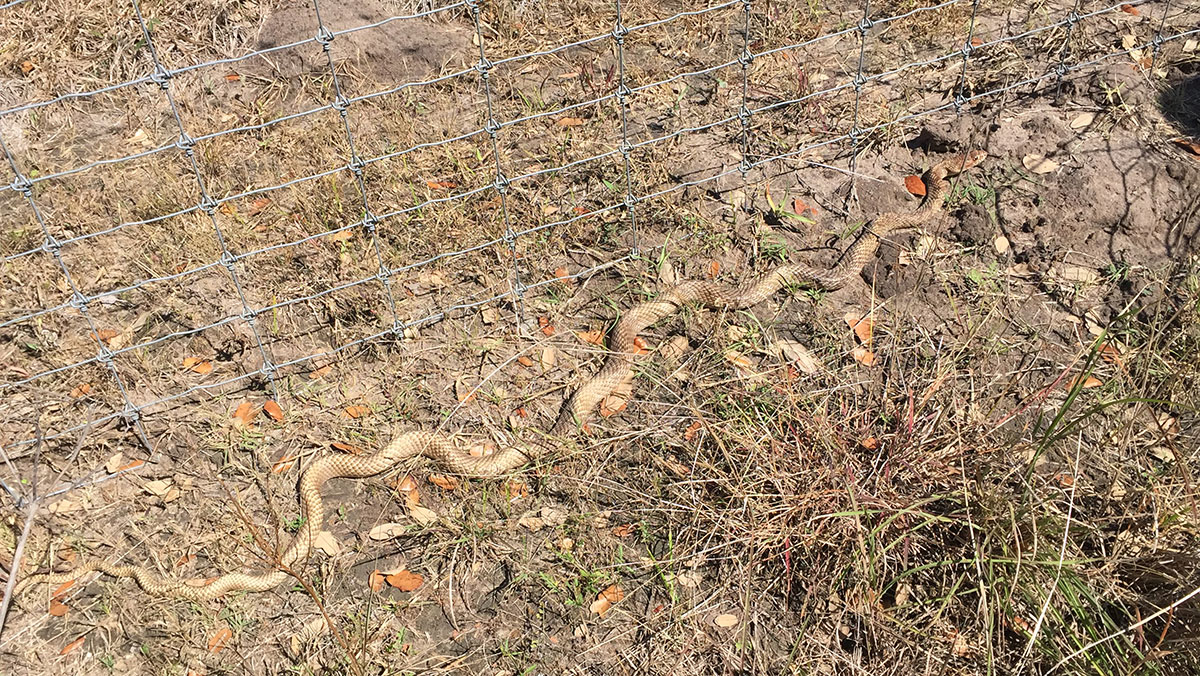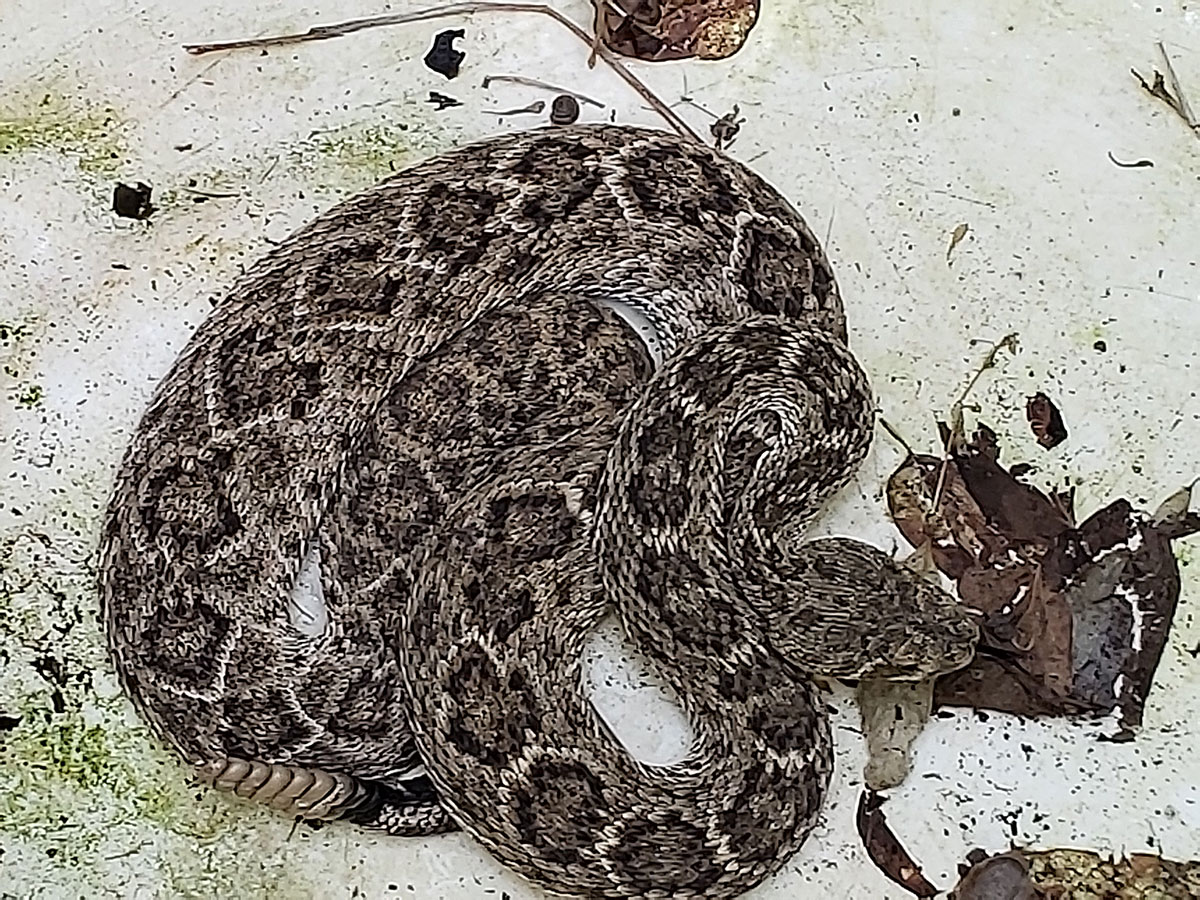Photo above: The farm’s first sign of summer, a rattlesnake (Crotalus atrox) in a barrel after being captured in our yard.
We know the beginning of summer on the farm not by calendar, but by nature. The clearest sign of summer is snakes. Specifically, rattlesnakes and copperheads. The first rattlesnake of the year marks the transition from spring to summer. The advent of summer triggers certain fish hatchery activities. It means it’s time to put shade cloth on our three greenhouses and to set up fans. We shift from letting the greenhouses collect heat to cooling them.
This year, summer started on Friday, April 27th. Susie, wife and business manager, was entering our house’s yard from the greenhouses at the beginning of lunchtime. But, as she and our rescue mutt hound, Sunshine, went through the yard gate, she saw a Western Diamondback Rattlesnake (Crotalus atrox) beside the path. Sunshine failed to see it and ran past into the house. Our German Shepherds, Oso and Maya, were behind Susie. She quickly closed the gate to prevent Oso and Maya blundering into the snake, which was quietly lying next to the path. The snake was relying on its camouflaging diamond pattern to hide it.
Susie returned to the greenhouses where I was completing a feeding to advise me of the snake. She exclaimed, “There’s a big rattlesnake in the yard!” When I asked how big she said it was probably four feet. That told me I’d definitely need our snake stick to capture it. We NEVER kill snake, poisonous or otherwise, so I searched the warehouse for the snake stick. No luck. I decided a long-handled fish net and a plastic push-in fence post would have to suffice. I wouldn’t need a container in which to place the snake since I had a couple of 55 gallon plastic barrels in the yard used for rainwater collection. I gathered the net and post and set off to capture the snake.
By the time I got to the yard, the snake had moved on. I was determined to find it since Western Diamondback Rattlesnakes are often nasty tempered and while ignoring them in our pastures, I move them out of our yard. Glancing around I didn’t see the snake, so I called Oso and Maya over to where Susie said the snake had been lying. They smelled the snake and tracked it to a nearby Arizona ash tree with a patch of ground cover growing at its base. I found the snake near the trunk. Susie’s estimate of the snake’s size proved to be exaggerated. The snake was under three feet long. I coaxed the snake into the net with the plastic post and carried it to a barrel, where it resided until later in the day when I released it in our east pasture where it could dine on mice and gophers.
After lunch I mowed a section of our yard and got the second sign of summer on the farm. A large Copperhead (Agkistrodon contortrix) was annoyed by the vibrations of the mower and crawled out of some ground covers near the area I was going to mow. Unlike Western Diamondback Rattlesnakes, Copperheads are even tempered and rarely aggressive. We photographed the snake and allowed it to crawl safely into another patch of ground cover. I don’t bother to relocate Copperheads, which during June and July congregate in our yard to eat the plentiful cicadas and June bugs (see my blogs about these snakes: Copperhead Eating a Cicada, Copperhead Hunting a Cicada, Copperhead in a Tree, Creepy Copper the Copperhead. Copperhead Eating Lizard, Copperhead Bites Sadie, Maya’s Copperhead Bite, and Maya’s Copperhead Bite Update).

The Copperhead’s head is to the left the photo. The snake is about 2.5 feet long. Mature adults such as this snake aren’t that well camouflaged. Youngsters are much duller in color and difficult to see.
These two snakes, the rattlesnake and the copperhead, weren’t the first snakes of the year. We’d already seen snakes such as the Western Hognose, Gray Phase Black Racers, Texas Ribbon Snakes, Diamondback Water Snakes, and Coachwhips. Indeed just a few days before while rescuing a coyote (Canis latrans) from a snare (blog on this to follow), our sons Carl and Nathan and I came across two Coachwhips (Masticophis flagellum) about fifteen feet apart. One slithered into its commandeered rodent hole and the other shot away into a brush mott. I suspect the snake entering the hole was a female and the other a male looking for a mating opportunity.



While we see snakes during every month of the year on the farm, it’s when we see rattlesnakes and copperheads that we realize summer is truly here.
There’s never a boring day on the farm.


Leave a Reply